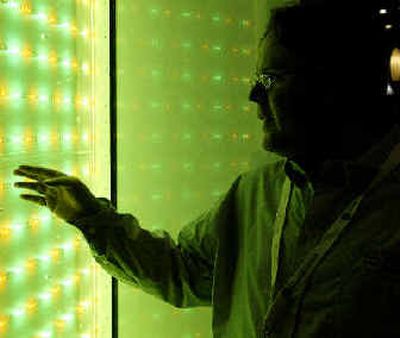Will LEDs outshine bulbs?

NEW YORK — If a time traveler from a hundred years ago were to visit a home today, much of the technology would be completely alien. The television, cordless phone and computer would probably leave him flabbergasted.
But on seeing a light bulb, he might say, “Ah! Here’s something I recognize. A few of those grace my home, too.”
If the visitor comes back in 15 years, the fruit of Thomas Edison’s bright idea may be gone. The likely replacement: light-emitting diodes, or LEDs.
LED lamps were unthinkable until the technology cleared a major hurdle just a dozen years ago. Since then, LEDs have evolved quickly and are being adapted for many uses, including pool illumination and reading lights, as evidenced at the Lightfair trade show here this week.
More widespread use could lead to big energy savings and a minor revolution in the way we think about lighting.
LEDs have been around since the 60s, but have mostly been relegated to showing the time in an alarm clock or the battery level of a video camera.
They haven’t been used as sources of illumination because they, for a long time, could not produce white light — only red, green and yellow. Nichia Chemical of Japan changed that in 1993 when it started producing blue LEDs, which combined with red and green produce white light, opening up a whole new field for the technology.
And the industry has been quick to exploit it. LEDs are based on semiconductor technology, just like computer processors, and are increasing in brightness, energy efficiency and longevity in a way that’s reminiscent of the way each year’s new crop of processors is faster and cheaper than last year’s.
Just this week, researchers at the Lighting Research Center at Rensselaer Polytechnic Institute in Troy, N.Y., said they had boosted the light output per watt of a white LED to almost six times that of an incandescent light bulb, beating even a compact fluorescent bulb in efficiency.
The current generation of mass-produced white LEDs is not as effective. It’s about twice as good as a light bulb of the same wattage, but the energy savings isn’t enough the overcome the major drawback of being expensive.
“It’s hard to convince consumers based on energy savings alone,” said Nadarajah Narendran, director of lighting research at Rensselaer. “If you look at compact fluorescent lamps, they’re four times as efficient as incandescent lights, and how many homes have those? It’s less than 5 percent penetration.”
But development is brisk, and the Department of Energy has estimated that LED lighting could cut national energy consumption for lighting by 29 percent by 2025. The total savings on U.S. household electric bills until then would be $125 billion.
LEDs have other advantages that are propelling them into niche uses, despite their upfront cost.
Current white LEDs will last up to 50,000 hours, about 50 times as long as a 60-watt bulb. That’s almost six years if they’re on constantly.
That makes them attractive for places where changing bulbs is difficult or expensive — like on the outside of buildings or in swimming pools. Osram Sylvania, the lighting subsidiary of German manufacturer Siemens AG, makes 27-foot long strips of flexible, adhesive tape covered in LEDs for such applications.